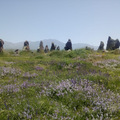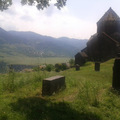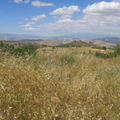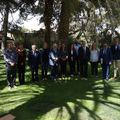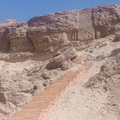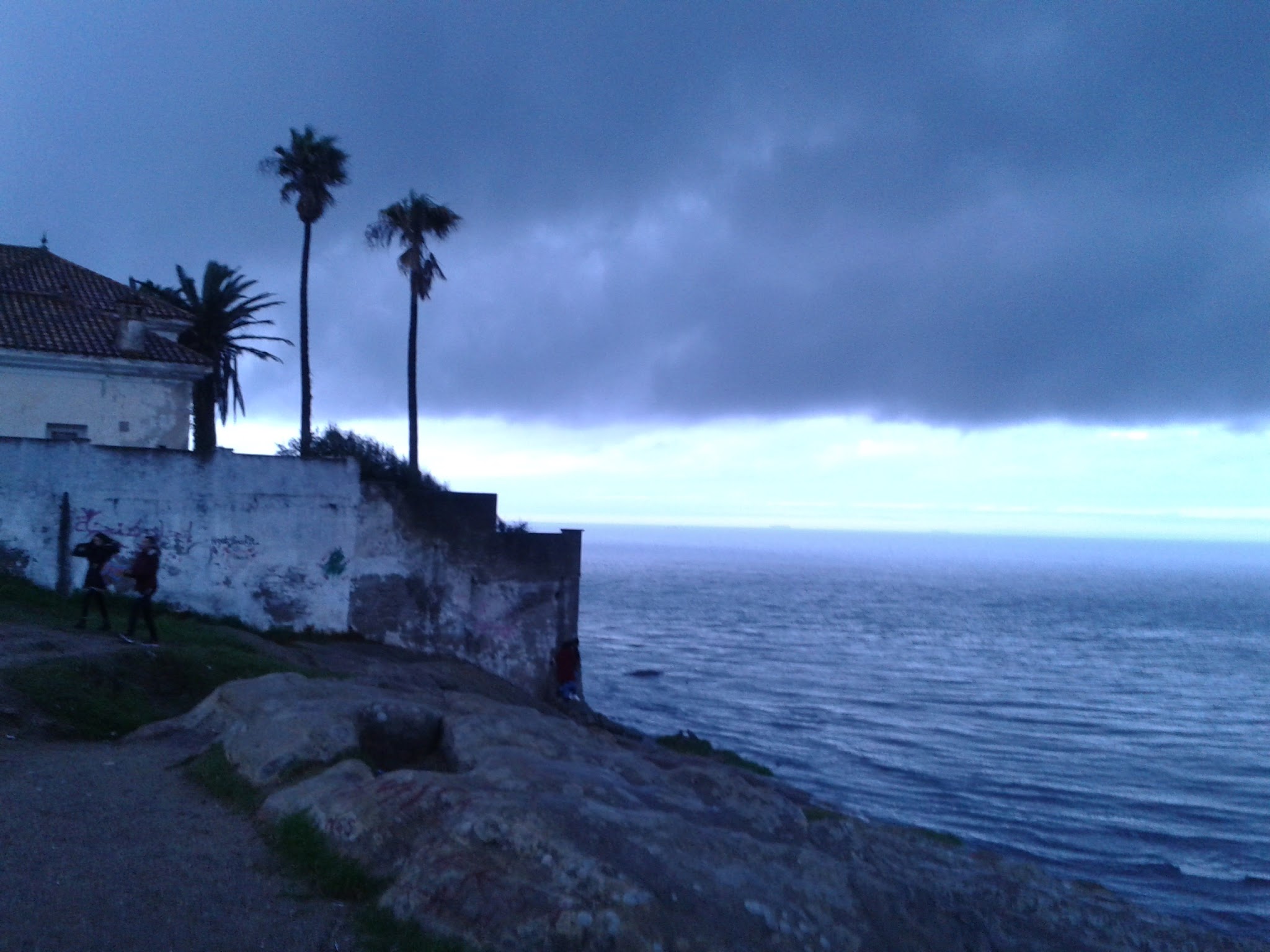
Tanger (lánykori nevén Tingisz) nemcsak az ókorász énemnek volt szerfölött izgalmas, hanem a régen elfeledett irodalmár énemet is megmozgatta. A városban az ötvenes-hatvanas években több író élt, mint kikötőmunkás (itt lakott/visszatérő vendég volt például Paul Bowles, William Burroughs, Samuel Beckett, Tennessee Williams, Jack Kerouac, Mohammed Choukri - és amúgy Faludy György is). Az amerikai/marokkói irodalom eme nagyjai a különböző kávéházak teraszai és a különféle kétes hírű hotelek penészes falú szobáin kívül a Librairie des Colonnes nevű könyvesboltban töltötték napjaikat, ami a mai napig (illetőleg manapság ismét) a marokkói irodalmi élet egyik fontos központja. Tangeri vendéglátónkról (aki Polly édesanyja barátnőjének a barátja) előzőleg annyit tudtam, hogy van valami könyvesboltja - úgyhogy nagyon fellelkesültem, amikor kiderült, hogy a Librairie des Colonnes tulajdonosának a kanapéján fogunk aludni. Lelki szemeim előtt már láttam, ahogy diadalmasan bekerekezünk a tangeri kulturális élet közepébe, és megérkezésünk után félórával már egy shisha mellett a modern magyar irodalom irányzatairól értekezek az arrajáró kortárs marokkói (esetleg amerikai és francia) írókkal.
Tanger, the ancient Tingis was interesting for me not only because of its archaeological remains (see the punic necropolis in the picture) but also because of its literary past - I had also studied literature after all. During the fifties-sixties there were more writers hanging around here than harbour workers - the list of names who lived here / visited Tanger frequently includes Paul Bowles, William Burroughs, Samuel Beckett, Tennessee Williams, Jack Kerouac, Mohammed Choukri (and also the Hungarian poet György Faludy). Beside spending their days in the various cafés an important meeting point for them was the bookshop Librairie des Colonnes, which still fulfils (to be more precise: fulfils again) a central role in the Moroccan literary life. I was very excited to find out that our host in Tanger, a friend of a friend of Polly’s mum is actually the current owner of this bookshop. I have already envisioned how we will cycle right into the middle of the cultural life of Tanger, and just after half an hour upon our arrival I will sit in one of the famous cafés in the bright sunshine and will conduct smart conversations with contemporary Moroccan (and maybe French and American) writers on the current trends in Hungarian and world literature.

(A kép forrása innen)
A Tangerbe való megérkezésünk majdnem olyan dicsőre sikerült, mint terveztem. Tarifában annyira esett az eső, hogy azalatt a 2 perc alatt, amíg a komp épületétől elértünk magáig a kompig, bőrig áztunk. A tenger iszonyúan hullámzott, és én biztos voltam benne, hogy ezt nem éljük túl. Az utazás fényét mérsékelten emelte, hogy egyes utastársaink nem jutottak el a mosdóig, hogy könnyítsenek magukon. Zöld arccal és háborgó gyomorral szálltunk partra. Az eső vigasztalanul zuhogott, az offline térképünk nem működött, a Lonely Planet térképei ebook-verzióban használhatatlanok, internetünk pedig ugye nem volt. Végülis másfél óra után, teljesen szétázva csak eljutottunk a könyvesboltig - ami amúgy 1,6 km-re van a kikötőtől, ha van az embernek térképe. Simon-Pierre azonban, mint azt később megtudtuk, maga is körbetekerte Európát, úgyhogy szerencsére nem akadt fenn semmin.
Everything happened almost as I imagined, although one should note the small and unimportant differences between plans and reality. It was, for example, raining hard already in Tarifa, and it didn't get better in Tanger. The 1-hour journey with the ferry was quite rough, I was convinced, I will never survive that waves. I was told that my face turned completely green. Eventually we landed and somehow managed to get out of the ferry. The bookshop is just 1,6 km away, we will be soon there, we thought. Our offline maps, however, didn't function, the maps in the Lonely Planet in its ebook-version are useless, and internet we obviously didn't have. So we didn't have a map of the city, I felt quite sick, I was freaking out that I have a bike with me in Morocco, and it was raining mercilessly. It took just 1-1,5 hour to find our way to the bookshop. Fortunately, as it later turned out, Simon-Pierre himself cycled through Europe so he was really understanding.

A könyvesboltban - aminek felkeresését mindenkinek ajánlom, aki Tangerben jár - amúgy találtam egy magyar könyvet is, Karinthy Epepéjét, amiből történetesen még anno a szakdolgozatomat írtam. Másnap aztán - miután meglátogattuk a gyönyörűszép Kasbah múzeumot, ahol a kurátor, Brahim, Simon-Pierre jó barátja, vezetett minket körbe - lelkiismeretesen végigturnéztuk az összes irodalmi kávézót is. Sajnos a senki nyakában nem függött a tábla, hogy kortárs marokkói író lenne - a kávék mindenesetre finomak voltak. A tangeri tartózkodásunk egyik nagy rejtélye volt számomra Baron von Distler-Dercsényi utcatábla, amire a medina egyik kis sikátorában bukkantam. Az online világban ugyanis semmi nyomát nem találtam Distler-Dercsényi bárónak. Szerencsére azonban művelt barátaim a facebookon felhívták figyelmemet Faludy emlékirataira, aki megemlíti, hogy tangeri tartózkodása idején találkozott egy Dercsényi-Distler báróval. A báró állítása szerint Wesselényi rokona volt, de egy szót sem beszélt magyarul; roppant gazdag volt és roppant zsugori, és kínaiból fordított arabra. (Faludy tangeri beszámolóját itt lehet elolvasni - köszönöm Bori és Andi a linket!) Ezek alapján roppant vicces figurának tűnik, szóval ha valaki tud róla még ennél is több információt, ne tartsa magában!
In the bookshop - which I strongly recommend visiting if you are in Tanger - I found also one Hungarian book, Epepe written by Ferenc Karinthy, which happens to be (together with three other novels) the subject of my master thesis - so was really happy to bump into it in Morocco. Next day we visited the beautiful Kasbah Museum where we got an excellent guided tour by the curator of the museum, Brahim, good friend of Simon-Pierre. Afterwards we did make the obligatory round to the literary cafes (no famous writers spotted though, but the coffees were delicious). While strolling through the streets of the medina, I found a street named "Baron von Distler-Dercsényi". I could recognize that it is a Hungarian name but couldn’t find anything out about who this person was, and was searching for it for days. Eventually my friends on Facebook helped me out (thanks Bori and Andi!): Baron Dercsényi-Distler is mentioned in the memoires of György Faludy who had met all the big names in Tanger when he lived there in the seventies. According to Faludy, Dercsényi-Distler was the most curious person he met in Tanger. Dercsényi claimed to be related to several famous Hungarian and Russian aristocrats (didn't speak any of these languages though), was very rich, super greedy and quite excentric. In his spare time he translated from Chinese to Arabic. Thus he seems to have been a very funny guy, so if you know something about him, don't hesitate to tell me!

